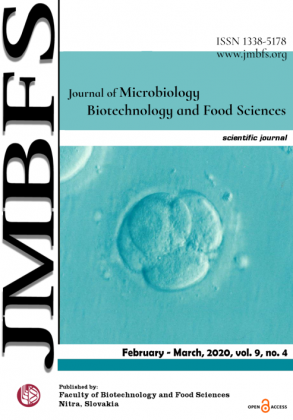SIGNIFICANTLY LOWER CONTENT OF ANTINUTRITIONAL SOLUBLE OXALATE IN AMARANTH MUTANT LINES DEVELOPED BY RADIATION MUTAGENESIS
DOI:
https://doi.org/10.15414/jmbfs.2020.9.4.820-823Keywords:
amaranth, soluble oxalate, nutrition, multivariate analysisAbstract
Soluble oxalate with potentially dietary injurious implications for human health were determined in amaranth (Amaranthus spp.) gamma-irradiation induced mutant lines by capillary isotachophoresis and compared to their non-irradiated reference samples 'Ficha' (Amaranthus cruentus L.) and interspecific hybrid 'K-433' (Amaranthus hypochondriacus × Amaranthus hybridus) during the cultivation period 2011–2014. The canonical discriminant analysis demonstrated significant differences among mutants and their reference counterparts during multiyear evaluation. Two-way ANOVA approach identified the mutant line D282 as variant with the significantly and long-term lowest soluble oxalate concentration in comparison to respective reference samples as well as other mutant lines. Decrease in a content of this antinutritional factor could be a possible effect of radiation-induced mutation event(s) in the D282 line genome. Therefore, this mutant line might be a good matrix in the further breeding programme of this naturally gluten-free pseudocereal.Downloads
Download data is not yet available.
Downloads
Published
2020-02-03
How to Cite
Hricová, A., Žiarovská, J., Suhaj, M., & LancÃková, V. (2020). SIGNIFICANTLY LOWER CONTENT OF ANTINUTRITIONAL SOLUBLE OXALATE IN AMARANTH MUTANT LINES DEVELOPED BY RADIATION MUTAGENESIS . Journal of Microbiology, Biotechnology and Food Sciences, 9(4), 820–823. https://doi.org/10.15414/jmbfs.2020.9.4.820-823
Issue
Section
Biotechnology
License
Copyright (c) 2020 Andrea Hricová, Jana Žiarovská, Milan Suhaj, Veronika LancÃková

This work is licensed under a Creative Commons Attribution 4.0 International License.
All papers published in the Journal of Microbiology, Biotechnology and Food Sciences are published under a CC-BY licence (CC-BY 4.0). Published materials can be shared (copy and redistribute the material in any medium or format) and adapted (remix, transform, and build upon the material for any purpose, even commercially) with specifying the author(s).





